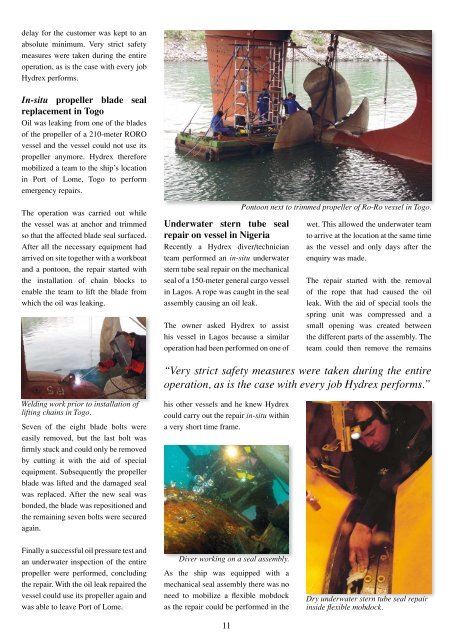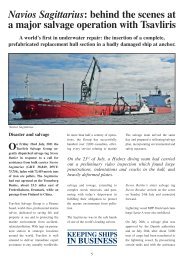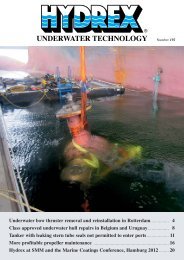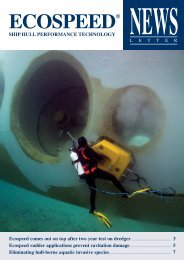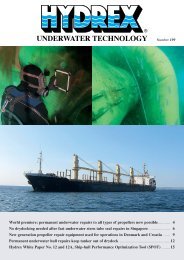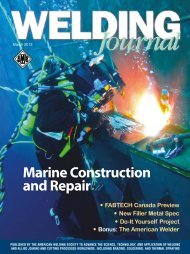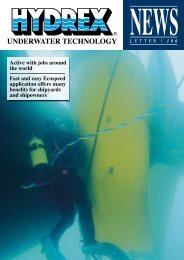Download - Hydrex Underwater Technology
Download - Hydrex Underwater Technology
Download - Hydrex Underwater Technology
Create successful ePaper yourself
Turn your PDF publications into a flip-book with our unique Google optimized e-Paper software.
delay for the customer was kept to an<br />
absolute minimum. Very strict safety<br />
measures were taken during the entire<br />
operation, as is the case with every job<br />
<strong>Hydrex</strong> performs.<br />
In-situ propeller blade seal<br />
replacement in Togo<br />
Oil was leaking from one of the blades<br />
of the propeller of a 210-meter RORO<br />
vessel and the vessel could not use its<br />
propeller anymore. <strong>Hydrex</strong> therefore<br />
mobilized a team to the ship’s location<br />
in Port of Lome, Togo to perform<br />
emergency repairs.<br />
The operation was carried out while<br />
the vessel was at anchor and trimmed<br />
so that the affected blade seal surfaced.<br />
After all the necessary equipment had<br />
arrived on site together with a workboat<br />
and a pontoon, the repair started with<br />
the installation of chain blocks to<br />
enable the team to lift the blade from<br />
which the oil was leaking.<br />
<strong>Underwater</strong> stern tube seal<br />
repair on vessel in Nigeria<br />
Recently a <strong>Hydrex</strong> diver/technician<br />
team performed an in-situ underwater<br />
stern tube seal repair on the mechanical<br />
seal of a 150-meter general cargo vessel<br />
in Lagos. A rope was caught in the seal<br />
assembly causing an oil leak.<br />
The owner asked <strong>Hydrex</strong> to assist<br />
his vessel in Lagos because a similar<br />
operation had been performed on one of<br />
Pontoon next to trimmed propeller of Ro-Ro vessel in Togo.<br />
wet. This allowed the underwater team<br />
to arrive at the location at the same time<br />
as the vessel and only days after the<br />
enquiry was made.<br />
The repair started with the removal<br />
of the rope that had caused the oil<br />
leak. With the aid of special tools the<br />
spring unit was compressed and a<br />
small opening was created between<br />
the different parts of the assembly. The<br />
team could then remove the remains<br />
“Very strict safety measures were taken during the entire<br />
operation, as is the case with every job <strong>Hydrex</strong> performs.”<br />
Welding work prior to installation of<br />
lifting chains in Togo.<br />
Seven of the eight blade bolts were<br />
easily removed, but the last bolt was<br />
firmly stuck and could only be removed<br />
by cutting it with the aid of special<br />
equipment. Subsequently the propeller<br />
blade was lifted and the damaged seal<br />
was replaced. After the new seal was<br />
bonded, the blade was repositioned and<br />
the remaining seven bolts were secured<br />
again.<br />
his other vessels and he knew <strong>Hydrex</strong><br />
could carry out the repair in-situ within<br />
a very short time frame.<br />
Finally a successful oil pressure test and<br />
an underwater inspection of the entire<br />
propeller were performed, concluding<br />
the repair. With the oil leak repaired the<br />
vessel could use its propeller again and<br />
was able to leave Port of Lome.<br />
Diver working on a seal assembly.<br />
As the ship was equipped with a<br />
mechanical seal assembly there was no<br />
need to mobilize a flexible mobdock<br />
as the repair could be performed in the<br />
11<br />
Dry underwater stern tube seal repair<br />
inside flexible mobdock.


